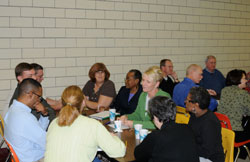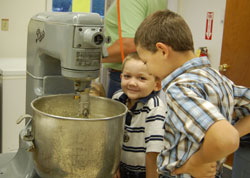Catholic News Around Indiana
Compiled by Brandon A. Evans
Diocese of Evansville
Town hall meetings underway for strategic planning
 By Paul R. Leingang (Message editor)
By Paul R. Leingang (Message editor)
A small number of people from several parishes attended the first of four Town Hall meetings, as part of the Strategic Planning Process underway in the Diocese of Evansville.
No registration was held, as part of the design to keep comments confidential.
Participants sat together at three tables, each with a member of the diocesan Discernment Team to record the comments made during the discussion, and to present a brief summary afterwards.
Two topics were proposed: “Describe a situation in your life, where the Church has been most meaningful to you,” and “Fast forward to the year 2015. What are your hopes, dreams and vision for the diocese and/or your parish? Be as specific as possible.”
The situation described as most meaningful was variously described as “being welcomed,” “being part of a small group,” “being part of a community,” “feeling at home” and “being filled with the Holy Spirit.” Other comments included good homilies, experiencing the sacraments, “participating in TEC (Teens Encounter Christ) or CRHP (Christ Renews His Parish), and typically involving some kind of “bonding.”
Comments gathered for the second topic, looking ahead to 2015, included “having a better job descripiton for priests” so that more lay people could be involved in the parish and the priest would be freed up for the sacraments; continuing education and more opportunities for women in church leadership roles.
In his opening remarks, Bishop Gerald A. Gettelfinger had noted that he just recently celebrated his 74th birthday and would be submitting his resignation at age 75 – while pointing out that the pope might not accept his resignation for a year or more, before allowing him to retire.
Bishop Gettelfinger has previously expressed an intent to live in the diocese after he retires. At the end of the meeting, he said he hoped he would “be here in 2015 to see what happens to this diocese.”
Photo caption: Table discussions take place during a Town Hall meeting at Mater Dei High School in Evansville, Oct. 26. (Message photo by Paul R. Leingang)
Book looks at woman’s struggle with mental illness
By Mary Ann Hughes (Message staff writer)
The book “My Mother Marie” was born out of great love, and as the author tells it, “it was accompanied by labor pains.”
Patti Happel Grannan of Evansville is the author of the newly published book entitled “My Mother Marie: One Woman’s Struggle with Mental Illness.” It’s the story of Marie Miller Happel, a woman who struggled through the Great Depression and the Second World War, and then with her own depression which eventually claimed her life.
“My children remember my mother as being basically an empty shell,” Patti said. “They didn’t know her as the vibrant, fun-filled woman that I remembered.”
Ideas for the book rolled around in Patti’s head for years. The actual writing took nine months “just as long as it would take to build a baby. I wrote the last words on my manuscript on the 11th of January, 2009. That would have been my mother’s ninety-eighth birthday. And I said with a big sigh, ‘Happy Birthday, Mom. I hope this is the best gift you ever got.’”
The book recounts life on Evansville’s west side during the twentieth century. The author begins her story with the “Great Flood of 1937 because I was born at that time, when a doctor came in a boat to deliver me in an attic apartment up by Reitz Hill.”
She says that some days writing the book was easy. Other days were harder. The biggest setback occurred when she lost 192 pages on her computer. “That was really difficult.”
The book is filled with her memories of family gardens, neighborhood gatherings to butcher hogs, religious sisters dressed in black habits and white wimples, and living as a Catholic in the 1940s when she was a young girl.
She writes about her mother’s struggle with mental illness which intensified during her menopausal years. “It was a horrible thing. She went to doctor after doctor after doctor.
“With mental illness, there is nothing you can do. It’s such a sad field. People just do not understand. Unless you’ve been there, you don’t have a clue.”
“My book is a testimony to my mother who never really knew her own worth. I hope she knows what I tried to convey with this book.”
(For these stories and more news from the Diocese of Evansville, log on to the website of The Message at www.themessageonline.org)
Diocese of Fort Wayne-South Bend
The importance of the Catholic funeral Mass
 By Karen Clifford
By Karen Clifford
Death is a subject most people don’t usually wish to talk about. But communicating final wishes to loved ones is vital.
Father Michael Heintz, rector of St. Matthew Cathedral in South Bend, Father Mark Gurtner, pastor of St. Anthony De Padua, South Bend, and Pat McGann, director of McGann Hay Funeral Home and a St. Pius X, Granger, parishioner, offer their views on the importance of preparing for a Catholic funeral.
Fathers Gurtner and Heintz point out that just as a will is important in expressing a person’s desires after death, a written document specifying wishes for a funeral can be made by Catholics as well.
“I think people should definitely prepare a document with their funeral wishes,” says Father Gurtner. “You don’t know what the situation will be in the future and where your family members are going to be at in terms of the faith, so for family members to have something specifically spelled out for you is very important.”
When children leave the church, Father Gurtner points out, they often do not realize the importance of the funeral Mass. “What we see happening is people that are good faithful Catholics, who go to Mass every week, sometimes everyday, are denied a funeral Mass because the children don’t know their wishes.”
Father Heintz encourages parishioners to plan their funeral rites and is happy to assist them. “This includes not only music and readings for the Mass, but also the vigil service at the funeral home and the committal service at the place of burial,” he says.
Each priest in the Diocese of Fort Wayne-South Bend is required by the bishop to keep a personal document specifying what music, readings and liturgical ministries they wish family members, friends or clergy to participate in during their funeral Mass. These documents are stored at the chancery office.
Father Gurtner recommends having several copies of funeral arrangements in several places, such as filed with the will, in the church office and with family members.
When the death of a Catholic is near the priest should be notified. “If you know the death is coming soon, you should call the priest so they can hear their last confession, anoint the person and give Communion,” says Father Gurtner.
“There is often a misunderstanding by some that a person will die and then the priest is called to give the last rites or anointing of the sick. The anointing of the sick can only be given to the living,” he continues.
Samaritan’s Feet reminds students to wash the feet of a child
FORT WAYNE — The sound of students’ feet echoing through the hallways as they entered the gym and climbed the bleachers was especially poignant during a recent assembly at Bishop Dwenger High School. Students and faculty gathered on Oct. 19 to make a presentation to the founder of Samaritan’s Feet, an international humanitarian organization providing shoes to children and disadvantaged people around the world.
Organized by the school’s Social Justice Club, a shoe and fund drive was held, which collected over 200 pairs of new shoes and more than $1,300 for the organization. The shoes will be sent to Liberia to be distributed during the Christmas season.
Founded in 2003 by Nigerian native Emmanuel (Manny) Ohonme, Samaritan’s Feet works to help alleviate human suffering by providing a message of God’s hope and love, brought home by the simple gift of shoes — something many children throughout the world have to do without.
The program began with a proclamation made by a representative of Mayor Tom Henry declaring Oct. 19, 2009 “Bishop Dwenger Samaritan’s Feet Day,” which encouraged all citizens to recognize and support the effort of the high school and the charity organization.
Samaritan’s Feet does more than simply collect and send shoes to needy children. They make the gift personal and life-changing. With every pair of shoes, someone — Samaritan’s Feet staff, board members, volunteers or missionaries — gets on his or her knees and washes the feet of each child. Then, the children are told God loves them as new socks and shoes are placed on their feet. Over 3 million pairs of shoes have been distributed to date, touching the lives of 3 million individuals through God’s love.
At the conclusion of his comments, Ohonme challenged the students of Bishop Dwenger, saying, “What is God asking you to do?”
He reminded them that as Americans, they are in a position of power compared to many children of the world. He asked them how much more each of them could do to not only help his cause, but to end suffering throughout the world.
(For these stories and more news from the Diocese of Fort Wayne-South Bend, log on to the website of Today’s Catholic at www.todayscatholicnews.org)
Diocese of Gary
No briefs this week
(For news from the Diocese of Gary, log on to the website of the Northwest Indiana Catholic at www.nwicatholic.com)
Diocese of Lafayette
Honduras orphanage draws Frankfort volunteer
By Caroline B. Mooney
FRANKFORT — “I envision the next 27 months of my life to be challenging, simple and beautiful.”
That is Kristina Ramos’ expectation as she begins volunteer work at Farm of the Child, an orphanage near Trujillo, Honduras. The 23-year-old Frankfort native and parishioner of St. Mary Church heard of it while in college and started there Oct. 1.
“God planted a seed in me when I saw a DVD about the Farm after a daily Mass,” she said. “I remember smiling with a friend of mine and we both said we really wanted to go there. Little did I know that four years later I would be part of the Farm’s mission.”
Principles of the Farm of the Child are service, simple living and spirituality. Volunteers live in Christian community and share their lives and the Gospel with the poor and the marginalized. Volunteer houseparents live in six family-style homes that each accommodate six to eight children. Orphans, from age 1 to 16, are grouped by age and developmental stage. The Farm compound has an elementary and middle school as well as a medical clinic.
About 15 single volunteers live in the same house, sharing bedrooms, with cold mountain water showers. Their diet consists of beans, rice, some vegetables, and some meat each week.
Ramos is a graduate of St. Mary’s College in Notre Dame, Ind., with a major in sociology and a minor in Spanish. She brings a great love of work with children to the Farm, several years of speaking Spanish, experience working with different cultures, and, “as much as I am capable of, a heart ready to serve and learn,” she said.
Doughnut makers carry on a tasty parish tradition
 By Caroline B. Mooney
By Caroline B. Mooney
OXFORD — What better way to start your day than Mass and fresh doughnuts? Members of St. Patrick Church are treated to the homemade delights after Sunday Masses, thanks to volunteers and the parish LifeTeen group.
The pastries, along with coffee, juice and milk, are free, with donations gratefully accepted. Those attending 7:30 a.m. Mass are the lucky ones who can eat doughnuts hot from the fryer.
Father Fred Gschwind, pastor of St. Patrick from 1958-69 and 1972-87, started the Sunday morning doughnut-making as a way for the high school Catholic Youth Organization “to give back to the church,” said parish secretary Nancy Brost. “It’s a nice way to support the kids’ group while teaching them to help the parish.”
Longtime parishioner Wayne O’Neal, who enjoys staying after Mass for the snacks and camaraderie, recalls that Father Gschwind started the doughnut-making in 1960.
CYO has given way to today’s LifeTeen group, which buys the ingredients and any profit goes to their group. The high school students make doughnuts most weekends, but other parish groups, including a sewing group and a Mexico mission group, take over occasionally.
“We have three crews of teenagers who make doughnuts each month,” Brost said. “The fourth weekend we ask for a family of volunteers.”
While warm, the doughnuts are dipped in white icing or rolled in cinnamon and sugar. Some volunteers also use chocolate icing and decorations for holidays, such as special St. Patrick’s Day doughnuts, Brost said.
Parishioner Cliff Barnard has been making the doughnuts since high school. He and his wife, Peggy, began doughnut making regularly for the parish about six years ago; they now have the help of their five children.
Parishioner Joe Kult said he enjoys having the doughnuts after Mass, “especially when the Barnards make them. When we don’t have them in the summer, a group of us go to breakfast together in Pine Village.”
Photo caption: Sam and Lane Barnard watch the dough mix as they help make doughnuts on a recent Sunday morning.
(For these stories and more news from the Diocese of Lafayette, log on to the website of The Catholic Moment at www.thecatholicmoment.org)
 By Paul R. Leingang (Message editor)
By Paul R. Leingang (Message editor) By Karen Clifford
By Karen Clifford By Caroline B. Mooney
By Caroline B. Mooney